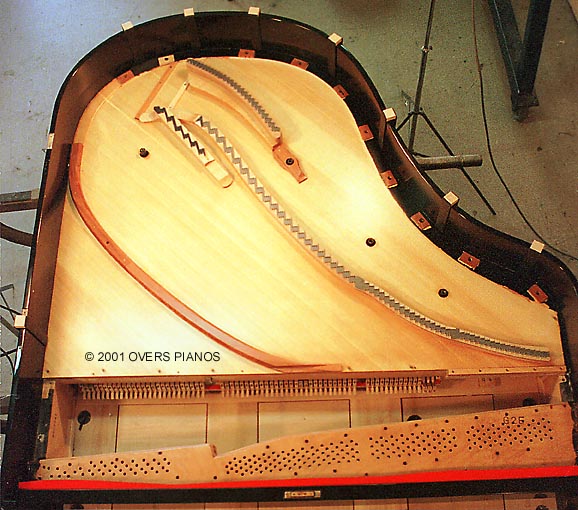YAMAHA G2 WITH SOUND BOARD CUTOFF

YAMAHA G2 WITH SOUND BOARD CUTOFF

The sound board cut-off bar (manufactured from Antarctic Beech - Nothofagus moorei - ADD 0.74 gr/cc) extends to the center of the belly rail. A damper wire guide rail mounting block was removed to make way for the cut-off bar, which now supports the treble section guide rail at its center.The added components which make up the balance of the sound board modifications can be seen towards the rear of the board. The last six notes on the treble bridge (B27-E32) were cut away to make way for the new tenor bridge (made from rock maple). The auxiliary ribs can be seen angling back towards the center of the float. The sound board panel has been edge tapered (by around 3 mm) adjacent to the ends of the float, extending to about 400 mm along the cutoff (and to a similar length on the opposite side of the board ). This was intended to lower the sound board impedance for the bass and tenor sections only. The bridge extension, at the upper end of the bass bridge (also made from Antarctic Beech), is designed to extend the support of the bass bridge across to the next adjacent sound board rib. The purpose of this modification is to increase the sound board impedance at the upper end of the bass bridge (this is necessary to reduce the typical 'woofy' tone found in many pianos at the upper bass). This sound board 'fix' is necessary when the bass bridge is placed at an inappropriate distance (ie. too far) from the inner rim. This is a very common design defect, even today unfortunately.
The small wooden blocks, sitting on the outer rim, are attached to insertion rubber strips which hang down on the inside of the outer rim. These act as a buffer against rim damage when inserting and removing the iron plate.
An 8 mm (5/16") diameter hole can be seen in the cut-off bar at approximately 140 mm (7") out from the outer rim. In this G2 installation, the cut-off bar was bolted to the adjacent bass strut from underneath the sound board. This performed two helpful functions, it decoupled the noisy strut - preventing it from resonating (thanks to the hysteresis loss qualities of the belly wood), while the strut provided additional support for the sound board cut off (which helps to reduce sound board energy loss, thereby increasing sustain).
The G2 plate was lowered at the rear (5 mm) to allow for the down bearing to be set to the desired angle. Since the sound board had adequate crown, the author suspects that this piano was not set up correctly at the factory regarding down bearing (the bridge heights appeared to be 'all over the place' while the board appeared to be uniformly crowned). After removing the original perimeter plate mounting blocks, the rock maple block on the inner rim adjacent to A1 was installed to set the revised plate height. The Antarctic Beech support blocks were manufactured to the required thickness after measuring the distance from the underside of the plate to the belly (at each perimeter bolt hole). The author has a special measuring tool for this purpose (manufactured in-house), which enables the plate/belly distance to be measured through the perimeter bolt holes, with the plate sitting in the piano at the desired height.
TO RETURN TO OVERS' MAIN BROWSER WINDOW, PLEASE CLOSE THIS WINDOW AT THE TOP-LEFT CLOSE BOX
First published 16 March, 2001
Copyright ©
2001, Overs Pianos.